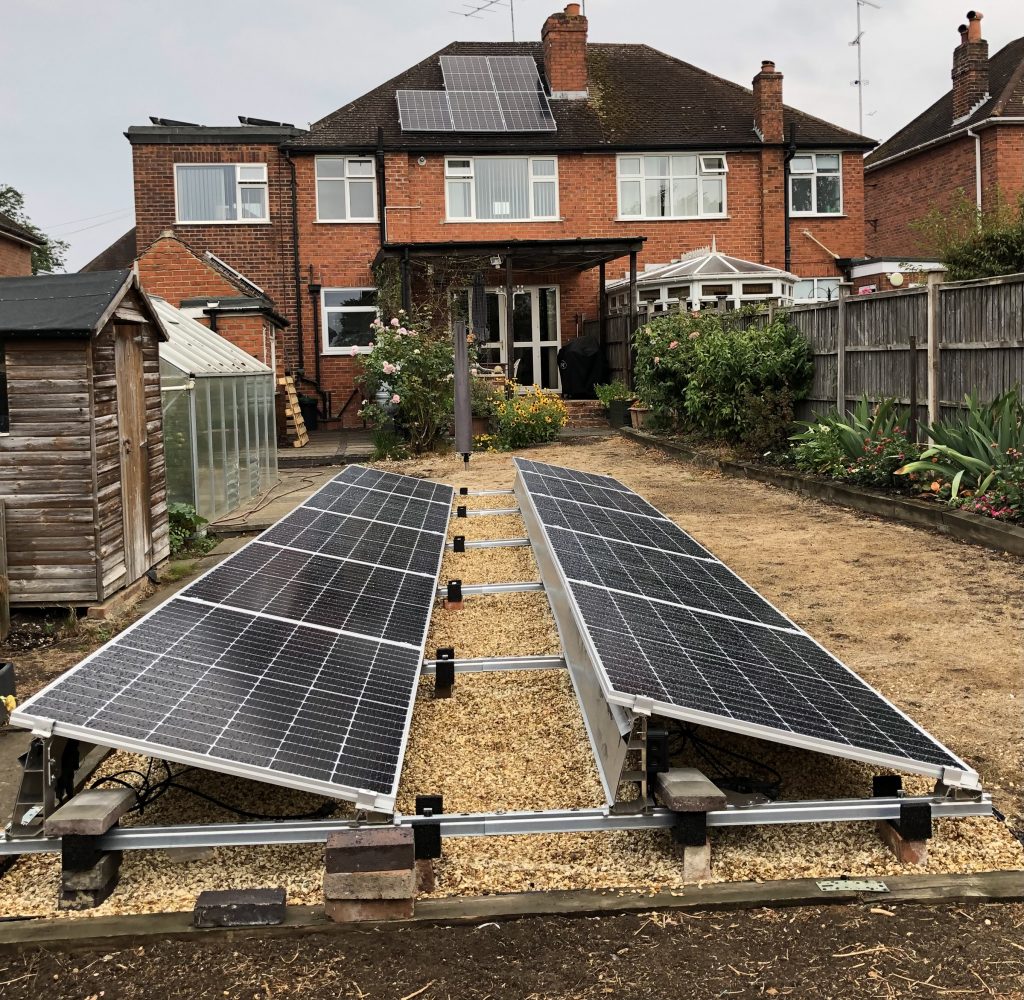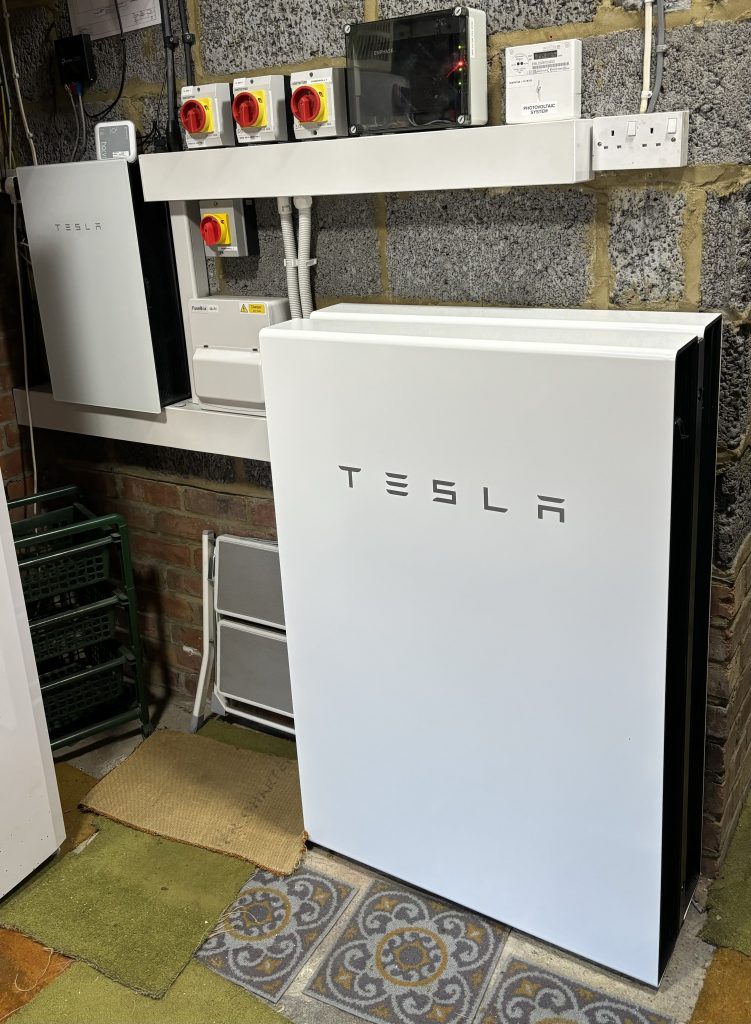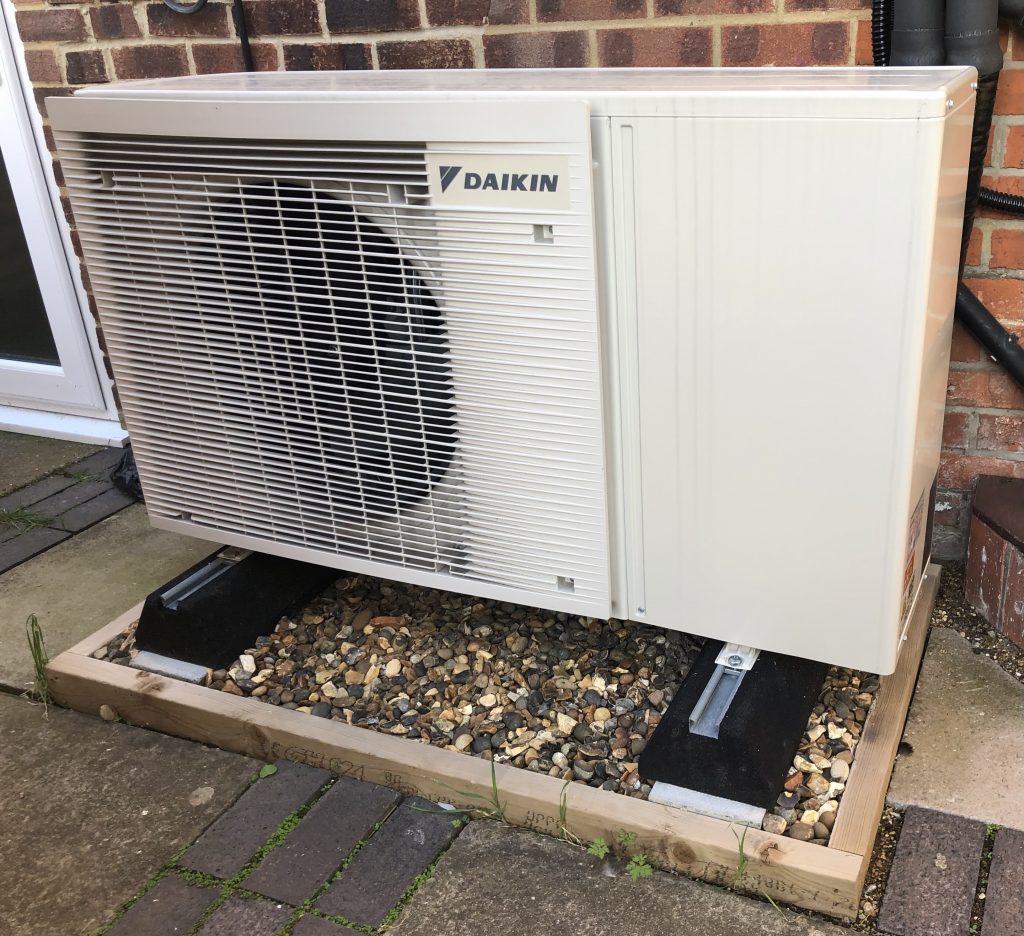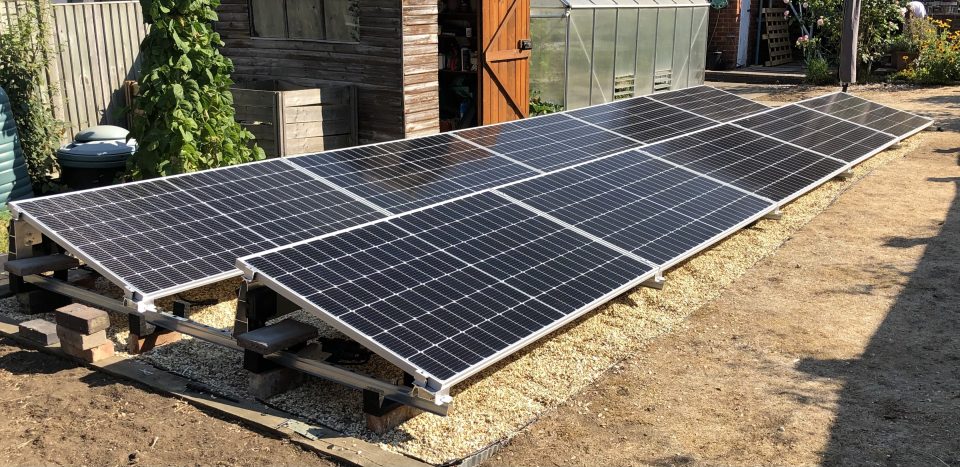Our house is a typical 3-bedroom, 1930s semi that has been extended to include an extra bedroom with a utility space below. Two years ago, I felt it was time to review our energy usage. We were heating with a time-expired gas boiler and using a selection of newer and older radiators, cooking on a gas hob, and had a mixture of tungsten, fluorescent and LED lighting. Researching methods, equipment, costs and benefits took time but yielded rewards. The work can be complex, and many installation companies try to simplify it with ‘packages.’ However, such packages may not always be the best solution, and knowing what I wanted to achieve enabled me to shortlist the options.
Stage 1: Improving Insulation
Improving insulation was necessary to reduce heat loss, a beneficial step regardless of the form of energy employed. Ground floor insulation was carried out by suit-clad operatives if the void was deep enough; otherwise, it was done using a remotely controlled robot to manoeuvre around the void by ‘caterpillar tracking’ and spraying as directed by a technician from above floor level while watching a monitor. A certified and guaranteed fire retardant foam was applied, ensuring that no air bricks were blocked, thus maintaining free airflow to the underfloor structure. Photos of before and after were provided, along with a guarantee for the work.
We also improved the loft by increasing the thickness of the ‘blanket’ to 300 mm, using a grant from the council. The work could be financed as long as an approved installer from the council’s list was employed. All windows are double-glazed, the wall cavities had been filled previously, and doors fitted with draught excluders, completing the first stage. Reducing heat loss should always be the first consideration – heating costs money, and money spent on this aspect is well spent.
However, be aware that you will still need ventilation in the home, usually achieved by having opening windows or air vents in any habitable space. Some double-glazed units have built-in closable vents at the top of the frame. There are systems that can be installed to allow fresh air from outside to be warmed via a heat exchanger by the ‘stale’ but warm air being ventilated from the kitchen, bathroom, etc. These mechanical ventilation & heat recovery (MVHR) systems are beyond the scope of this article, as I have not had any installed, but many companies offer a wide range of solutions. I feel that these systems are most suitable for new builds rather than retrofits, as there is usually a certain amount of air ducting involved in the designs.
EPC (Energy Performance Certificate)
After the insulation work was completed, I had an inspector assess the dwelling for an EPC, as this had not been done previously. This assessment is required by the government when applying for a grant called the Boiler Upgrade Scheme (BUS). The rating was ‘C’ (72), with notes indicating that improvements made by fitting solar water heating and solar PV panels had the potential to raise this rating to ‘B’ (83). I believe that the subsequent work detailed below more than covered this requirement.
Stage 2: Solar Power
Research showed that producing my own electricity from solar photovoltaic (PV) panels would be a very good start. Placing solar panels on your roof falls under ‘permitted development,’ thus not requiring planning permission. To produce enough energy for day-to-day needs, I used several roof areas and also placed some panels in the garden. Chimneys may cast shadows over some panels during parts of the day, reducing their production at those times.
Not only do I have shading from a chimney, but also from late September, I experience shading from nearby trees until their leaves drop some weeks later, after which the production slightly increases. My PV array has a total rating of 8.1 kWp (peak), which on a good sunny summer day may produce 35-40 kW/h. However, this figure may drop to approximately 4 kW/h in winter due to the low-lying sun and resultant shading, as well as the reduced solar energy. For instance, solar production for September 2023 amounted to 662 kW/h, while the production for December 2022 was 107 kW/h.

Regarding the siting of panels, the ideal orientation is due south. However, the orientation of your house or other buildings may dictate this for you. Panels can face east, south, or west, or points in between; it is best to avoid north. The inclination is dictated by the angle of the roofs, and again, this will be fixed. My own panels are sited in varying orientations, some SSE, others SW, so slightly less than optimum. An array with varying orientations is beneficial as the harvest is spread over more hours as the sun tracks around.
I looked for the most efficient panels and decided that individual micro-inverters on them would provide the most reliable performance. Individual micro-inverters ensure that any shaded panels don’t restrict the output from other panels. There are also ‘string inverters,’ but some of these are affected by shading to a lesser or greater degree.
The micro-inverters are needed to convert the Direct Current (DC) from each panel to Alternating Current (AC), unifying the voltage before sending it to the controlling switchgear, which is situated, along with the battery, in the extension at the side of the house. Some battery systems can be situated outside, while others need to be sheltered from the elements. Either way, I feel that if they are in a dry, frost-free environment away from extremes of heat and cold, they are likely to have a longer active life.
I had a survey carried out to ensure the house roof was sound and capable of supporting the weight and any uplift pressures from the PV panels fitted to it.
Our daily electrical needs, excluding domestic hot water heating, averaged 10 kW/h before starting stage 1 (at that time, the gas boiler also supplied the heat for the water heating). Energy storage was necessary to utilize any ‘excess’ produced in sunny times later (mainly in the evening and at night), but also to enable the best use of cheap rate grid power to charge the battery off-peak during gloomy days and winter, while avoiding using peak rate energy from the grid. I wanted a battery capable of storing at least 12 kW/h of energy. Initially, 13.6 kW/h of capacity was fitted but later increased.
To ensure we could power the heat pump through any short-duration power cuts and also store more ‘off-peak’ (cheaper) power to run the heat pump during ‘peak hours,’ I doubled the battery to provide a total of 27 kW/h of energy in-house. Having such capacity initially was not feasible as the batteries were in very short supply at that time.

I found a company capable of installing to my requirements at a total cost of £27,500. Although this is a considerable sum compared to some ‘packages’ offered, the result provided almost everything I required. From spring to mid-autumn, the solar PV normally provides all the power we need day-to-day and enables any excess to be exported. This means we receive credit for every kW/h, which goes towards paying the winter bills.
N.B. Running a heat pump requires more energy than such a PV system might provide during those dark winter days, and grid power may be needed at such times.
It is worth noting that bright sunshine provides the panels with the greatest opportunity to produce power. It is the photons hitting the panel that provide the energy, not the heat. Standard Test Conditions (STC) are used to measure the performance of PV panels; STC require that the performance is measured at an ambient temperature of 25 degrees C. As panels get warmer, their efficiency reduces.
A ballpark figure of 0.25 – 0.4% per degree rise in temperature indicates that when I measured my panel temperature on a summer day as 65 degrees, my panels were losing some 10% due to the rise in temperature. A cold but bright winter day can be quite productive. Another factor is the lifespan of the panels; many are sold with a 10, 20, or even 25-year warranty. However, the efficiency of the panels will drop due to aging. Panels may well drop to 80% of their original performance over time.
Energy providers often offer a wide range of tariffs, including fixed rates and various flexible schemes. There are schemes suited to heat pump owners where there are several rates at different times of the day, and tariffs suited to owners of EVs allowing electric vehicles to be charged overnight at cheaper rates. As I don’t drive, I cannot avail myself of such schemes, but I do use a tariff where the rate varies every half hour, often providing low-priced energy, particularly during the early hours.
The amount of power your system is capable of exporting to the National Grid depends on the equipment and the energy your array can produce. You may need to seek permission from your DNO (Distribution Network Operator), locally this is Scottish & Southern Electricity, to connect any apparatus to the grid. There are various application forms for this, depending on the amount of production involved; mine was applied for under a ‘G99’ application, but all this will be handled by your installer.
Another aspect to consider if you have a battery as part of your solar power installation is whether you wish to continue powering your home during a power cut. The unit I have to control the solar kit has a facility generally known as ‘Islanding.’ If the grid goes down, all solar power systems are required to disconnect from the grid for safety reasons. This is because if an engineer were working on the grid cables to effect a repair and your solar power was still linked to the grid connection, the engineer would be at great risk of electrocution. If your control equipment doesn’t have an ‘Islanding’ facility, it must stop producing power altogether, resulting in your system not supplying any solar power or battery storage until the grid is online again.





Stage 3: Heating and Hot Water
Research had been ongoing, so once the solar aspect was settled, I contacted installers who might install an air source heat pump. Finding a company that was willing and competent to install the components I desired, willing to travel to Earley, and had MCS, RECC, and NAPIT accreditation – official installers and stockists of the items I wanted installed – was quite a task. I contacted over 20 companies, many of which did not reply or were unwilling to work in this area. I shortlisted five companies. Of these, only three were prepared to come here and carry out the necessary survey to calculate the building’s heat loss and establish the requirements for radiators, pipework, siting, etc. The surveys were carried out; one was very cursory and was dismissed, and another was rejected, so the choice was made.
I decided on a monobloc unit, sited at the rear of the house. Heat pumps can be built with an external and an internal unit (generally referred to as ‘split’ units), where some of the ‘gubbins’ are sited indoors. Others, such as a monobloc design, have a larger unit sited outdoors with insulated pipework that, in our case, runs up the house wall and into the airing cupboard space where it connects to control gear and internal plumbing.

The size of the domestic hot water tank required by the Microgeneration Certification Scheme for a 4-bedroom house (220 liters) would not fit in the airing cupboard. Therefore, a unit that stores energy in a ‘salt & vinegar’ phase change material, which is a quarter of the size, was employed. This unit runs on solar and/or grid power.
The phase change material is similar to that used in hand warmers, which are activated to produce heat and can be reused by immersing the warmers in hot water to revert the material to its original state. In the case of the water heater, an immersion element heats the phase change material, which is stored ready to provide heat to the pipework running through the unit, similar to a combi boiler providing instant hot water.
Because no hot water is stored in the system, there is very little risk of legionella, eliminating the need for weekly cycles of heating the water above 60C to kill off any harboring bacteria. The unit is very well insulated, and the heat loss per day is less than 0.75 kW/h; any heat that ‘escapes’ is ‘always useful’ as it is within the airing cupboard. The unit, not only a quarter of the size of a hot water tank, requires just a cold main feed and a hot water pipe out, plus an electrical main connector with control logic wiring.
The unit I specified is heated using electricity, but there are also versions that can be connected to a high-temperature heat pump and use heat from the pump. Many intelligent domestic hot water tank systems have a plethora of pipes, connections, and controls attached at various places on the tank, which I did not want to even contemplate.
Most radiators were replaced with larger ones suited to the purpose, as heat pumps generally run at lower temperatures than oil or gas boilers, thus requiring a greater surface area to emit sufficient heat. An advantage is that the heat is far more even, and we have no hot or cold spots anywhere in the house now. The radiators/emitters feel just lukewarm to the touch, but they are capable of keeping the house at a cozy temperature. The usual practice is to run the heat pump 24/7 at a very low temperature – slow and steady.
A dual fuel towel rail was added in the bathroom (for pure luxury), heated by an electrical element in the summer on a timer and by the heat pump in colder weather. The heating and domestic hot water installation was a large retrofit project, including the removal of a time-expired gas boiler, an old hot water tank, a cold water storage tank, and associated plumbing in the loft. It also involved alterations to the pipework, as well as filling and repairing all the old holes. The total cost, including an energy diverter to power the hot water system from solar power when abundant, came to £25,500. This cost included doubling the battery storage capacity as well. The ‘Boiler Upgrade Scheme’ deduction of £5,000 was applied at this point to the installer’s invoice, as it had all been approved in advance. Since this work was carried out, the government has promised to increase the ‘BUS’ to £7,500.
There is at least one company now producing and able to supply and install a high-temperature heat pump that could fit ‘straightforward’ installations within the grant amount. This installation would cover situations where existing radiators (otherwise called ’emitters’) are sufficient, and all existing pipework is satisfactory. If additional work or parts were needed, an extra charge might be applied to the installation.
Smaller heat pumps may be fitted under ‘permitted development’; there are requirements for maximum sound levels and minimum distance from the neighbor’s boundary and their windows that must be observed. In addition, there may be restrictions on the siting of the pump with regard to windows, doors and drains, so this is a matter to be discussed with potential installers and to seek their advice. Different refrigerants are used in the various compressor designs in heat pumps; some of these gases are ‘heavier than air.’ In the event of a leak, these combustible gases could lay at ground level and enter drains, etc. Extra restrictions on the siting of these units are required to reduce risks should there be an accidental leak. My monobloc unit uses R32 refrigerant, which is inert and safer in restricted spaces.
In the Kitchen and Around the House
Cooking is carried out with combination microwave cookers and an induction hob, and all lighting is LED – there is now a wide range of LED lighting equipment available. Gas has been dispensed with, and the metre removed, thus saving on the ‘standing charge’ normally paid for the gas supply to the house. The whole house is now powered by green renewable electricity. When we don’t produce sufficient solar power, our energy provider supplies us with any extra renewable energy we need.
Some of the Benefits
As stated, insulation to conserve energy is paramount. Once carried out, you will benefit every year thereafter. A heat pump consumes approximately one-fourth the energy a gas boiler requires to produce equivalent heat. A gas boiler in good working order might reach 90% efficiency, whereas a heat pump could be 350% efficient or more. Photovoltaic panels ‘keep on giving’ and are well worth installing. I would like to see the price of electricity equalised with that of gas, rather than at present, where the price includes a hefty levy and is governed by the wholesale price of gas – but if wishers were horses…
Before You Go Ahead
Most of the above projects involve serious amounts of expenditure; I strongly recommend you give the matter serious consideration before embarking on the installation of any renewable energy products. I feel such investment is very worthwhile. Don’t expect to see a large return on your investment in a few short years; however, with energy prices having risen so far now, you might find you would see a return on investment in perhaps 7-8 years. This estimate might not apply to the installation of a battery due to their cost, but they do have many advantages – not least of which is the ‘peace of mind’ provided by the ability to ride through short power outages, and they could have a life expectancy of 15-20 years.
I’m retired and a self-confessed nerd who finds time on a daily basis to check the prices of the dynamically priced energy my tariff provides. I am able to choose the greenest and cheapest times to use the grid to charge my battery and heat the hot water system for the following day. I realise this arrangement may not suit everyone, but it does provide me with cheaper, clean energy and keeps me out of mischief.
I have a background in mechanical, electrical and audio engineering. I’m no expert, but I do use my knowledge to assist me in my decisions, and this has proved very useful when dealing with potential suppliers and installers. There are many sources of genuine information via the internet and help groups and forums that specialise in renewable energy projects and products. I cannot help you sort the scammers and cowboys from the genuine ones, so a little knowledge gained from such forums is well worth the effort of joining, reading and writing about your proposed project.
Please bear in mind that most genuine installers provide a guarantee of their workmanship and often provide 10 years (or more) coverage against product failure. There are also insurance companies that offer protection for many years to cover your installation should the installers ‘go to the wall’; this insurance will be included in the written contract your installer should provide. A search on the web will provide many official national organisations with advisory information and details of standards and good practice.


